|
We hope this message finds all our FWC volunteers and families healthy. In this newsletter, we share some of the exciting ways our volunteers have served the FWC since the start of the new year. Each of you has so much skill, talent and heart. We appreciate, admire and thank you for your dedication to conservation!
— the FWC's Volunteer Program Team
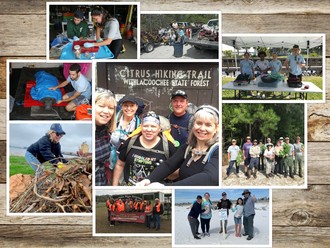 Volunteers and interns participate in a variety of species and habitat programs throughout the state of Florida. Manatee rescue (first photo second row) activities were conducted under United States Fish and Wildlife Service permit #MA770191.
Ridge Ranger Debris Cleanup at Carter Creek Tract
Before the Carter Creek tract on the Lake Wales Ridge Wildlife and Environmental Area was fenced, illegal dumping was a pervasive problem. In January and February, Ridge Rangers removed large appliances and other furnishings that were uncovered during a prescribed burn on the area.
Removing these items not only restores the natural beauty of the area but also protects wildlife and people from hazards such as leaking fluids, glass and rusty metal. In total, 2,600 lbs. of debris was removed from the site. Way to go, Ridge Rangers!
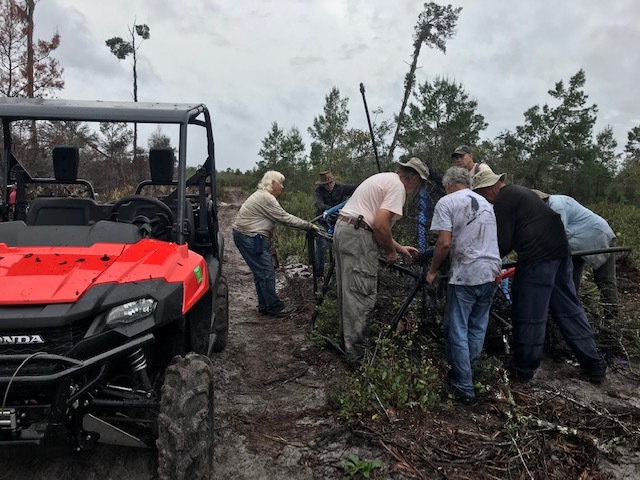 Ridge Rangers work to break down an abandoned trampoline left on site. Photo by FWC staff.
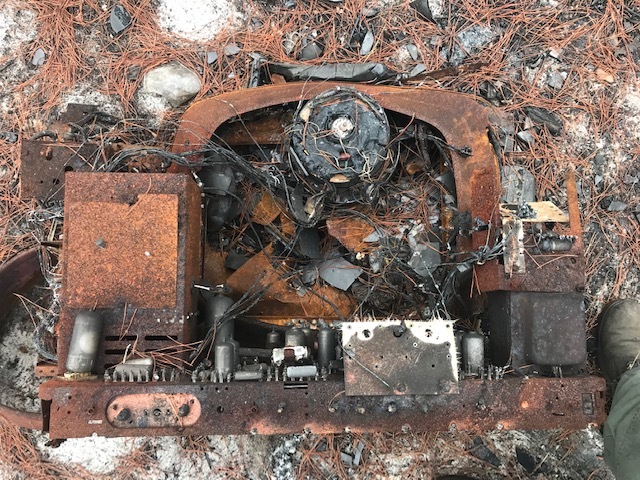 The inner contents of the back end of a television. Four televisions were found at the site. Photo by FWC staff.
 This discarded toilet was full of cracked and whole hickory nuts and acorns, evidence that an animal, possibly a squirrel or a bird, had been using it to cache food. Photo by FWC staff.
 Everything including a kitchen sink! Discarded items at the site included a washer and dryer, a refrigerator, lawnmower, stove, four televisions, a bicycle, numerous water tanks and two toilets, among other items. Photo by FWC staff.
Community Leap Day Beach Cleanup
To make the most of their extra day this Leap Year, almost 200 volunteers participated in a community beach cleanup in Panama City Beach to ready the beaches for beach-nesting birds, sea turtles, and human visitors alike. The FWC joined Keep PCB Beautiful, Audubon Florida, PCB Turtle Watch, SpringHill Suites, Hampton Inn & Suites and Bikini Beach Resort to host a cleanup along a four mile stretch of beach. Almost 2,000 pounds of trash was collected, and volunteers were able to learn about the imperiled species that utilize our beaches to mate, nest and raise their young!
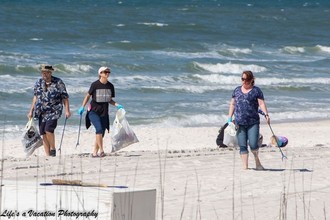 Volunteers collect trash along Panama City Beach. Photo by Life’s a Vacation Photography.
 Audubon Florida and Panama City Beach Turtle Watch volunteers teach cleanup participants about beach-nesting birds and sea turtles. Photo courtesy of Keep PCB Beautiful.
Wetland Restoration
In February, 24 volunteers joined forces with the FWC, Virginia Tech, Texas A&M, Eglin Air Force Base and Jackson Guard to restore a large area of wetland habitat in Okaloosa County. Volunteers, including several from Gulf Power, helped remove overstory vegetation that was shading out the wetland habitat. Thank you, volunteers, for your 120 hours of very hard work!
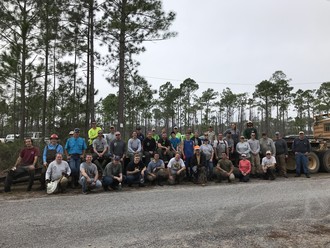 Volunteers and staff from the FWC, Eglin Air Force Base, Jackson Guard and AmeriCorps take a break for a quick photo. Photo by FWC staff.
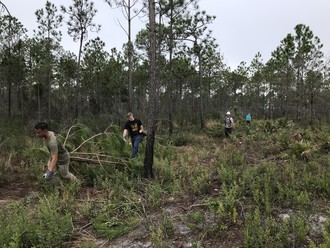 Volunteers help remove trees from the area during the habitat restoration workday. Photo by FWC staff.
Lake Okeechobee Pondweed Plantings
This winter, volunteers and staff spent two mornings planting pondweed on the south end of Lake Okeechobee. Pondweed, also called peppergrass, is a common native submersed plant that benefits the ecosystem in a variety of ways. Pondweed provides habitat for small insects and fish as well as food for larger fish and other wildlife. It also helps improve water quality and clarity. After many years of high water and Hurricane Irma in 2017, Okeechobee had lost most of its submersed plants. While many species of submersed plants have started to come back due to lower water levels since spring 2019, pondweed has struggled to return on its own.
A total of eleven volunteers and five staff planted approximately 850 pondweed plants. Plants were taken from a donor site in Hendry County. After the plantings staff went back on-site and were happy to see that some plants have made it through the first month, which is usually the hardest part of the transition! Soon we should see these pondweed plants stabilized and hopefully expanding.
 Volunteers and staff harvesting pondweed from a pond in Hendry County. Harvesting Florida pondweed requires a permit from FDACS as well as the owner’s permission. Photo by FWC staff.
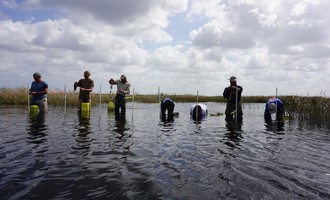 It is important to avoid stepping on the recently planted pondweed. Volunteers used poles to mark the start of a planting transect and walked backwards until all of the pondweed had been planted. Photo by FWC staff.
 Volunteers are happy to get involved with the FWC’s habitat management actions. Photo by FWC staff.
Parasitic Love Vine Removal
During a windy and rainy morning in February, staff and volunteers from FWC and Palm Beach County Environmental Resources Management (PBC ERM) joined forces to remove love vine from Hypoluxo Scrub Natural Area. Love vine is a parasitic vine that, if left unchecked, can take over and kill their host plant. It can also grow and extend rapidly over the open sandy patches of the scrub which provides habitat for the state-Threatened gopher tortoises and endemic Florida scrub lizards present at Hypoluxo Scrub Natural Area. Thanks to this collaboration and all the volunteers’ efforts, we were able to remove 400 pounds of love vine in less than three hours!
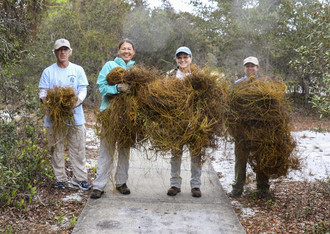 Volunteers and staff working happy under the rain. Photo by PBC ERM.
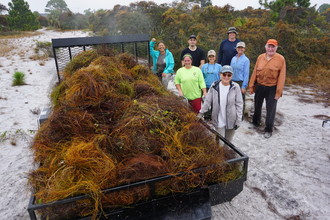 Four hundred pounds of parasitic love vine removed! Photo by FWC staff.
 What a difference of before and after the volunteer workday! Photo by FWC and PBC ERM.
|